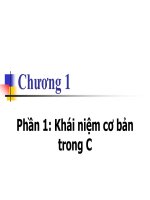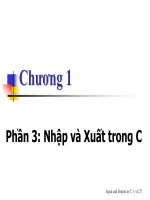Giáo trình C++ - Ngành CNTT - Part 04
Bạn đang xem bản rút gọn của tài liệu. Xem và tải ngay bản đầy đủ của tài liệu tại đây (2.97 MB, 91 trang )
Copyright © 2007 Pearson Education, Inc. Publishing as Pearson Addison-Wesley
Chapter 4
Procedural Abstraction and
Functions That Return a Value
Slide 4- 3
Copyright © 2007 Pearson Education, Inc. Publishing as Pearson Addison-Wesley
Overview
4.1 Top-Down Design
4.2 Predefined Functions
4.3 Programmer-Defined Functions
4.4 Procedural Abstraction
4.5 Local Variables
4.6 Overloading Function Names
Copyright © 2007 Pearson Education, Inc. Publishing as Pearson Addison-Wesley
4.1
Top-Down Design
Slide 4- 5
Copyright © 2007 Pearson Education, Inc. Publishing as Pearson Addison-Wesley
Top Down Design
To write a program
Develop the algorithm that the program will use
Translate the algorithm into the programming
language
Top Down Design
(also called stepwise refinement)
Break the algorithm into subtasks
Break each subtask into smaller subtasks
Eventually the smaller subtasks are trivial to
implement in the programming language
Slide 4- 6
Copyright © 2007 Pearson Education, Inc. Publishing as Pearson Addison-Wesley
Benefits of Top Down Design
Subtasks, or functions in C++, make programs
Easier to understand
Easier to change
Easier to write
Easier to test
Easier to debug
Easier for teams to develop
Copyright © 2007 Pearson Education, Inc. Publishing as Pearson Addison-Wesley
4.2
Predefined Functions
Slide 4- 8
Copyright © 2007 Pearson Education, Inc. Publishing as Pearson Addison-Wesley
Predefined Functions
C++ comes with libraries of predefined
functions
Example: sqrt function
the_root = sqrt(9.0);
returns, or computes, the square root
of a number
The number, 9, is called the argument
the_root will contain 3.0
Slide 4- 9
Copyright © 2007 Pearson Education, Inc. Publishing as Pearson Addison-Wesley
Display 4.1
Function Calls
sqrt(9.0) is a function call
It invokes, or sets in action, the sqrt function
The argument (9), can also be a variable or an
expression
A function call can be used like any expression
bonus = sqrt(sales) / 10;
Cout << “The side of a square with area “ << area
<< “ is “
<< sqrt(area);
Slide 4- 10
Copyright © 2007 Pearson Education, Inc. Publishing as Pearson Addison-Wesley
Back
Next
Display 4.1
Slide 4- 11
Copyright © 2007 Pearson Education, Inc. Publishing as Pearson Addison-Wesley
Function Call Syntax
Function_name (Argument_List)
Argument_List is a comma separated list:
(Argument_1, Argument_2, … ,
Argument_Last)
Example:
side = sqrt(area);
cout << “2.5 to the power 3.0 is “
<< pow(2.5, 3.0);
Slide 4- 12
Copyright © 2007 Pearson Education, Inc. Publishing as Pearson Addison-Wesley
Function Libraries
Predefined functions are found in libraries
The library must be “included” in a program
to make the functions available
An include directive tells the compiler which
library header file to include.
To include the math library containing sqrt():
#include <cmath>
Newer standard libraries, such as cmath, also require
the directive
using namespace std;
Slide 4- 13
Copyright © 2007 Pearson Education, Inc. Publishing as Pearson Addison-Wesley
Display 4.2
Other Predefined Functions
abs(x) int value = abs(-8);
Returns absolute value of argument x
Return value is of type int
Argument is of type x
Found in the library cstdlib
fabs(x) double value = fabs(-8.0);
Returns the absolute value of argument x
Return value is of type double
Argument is of type double
Found in the library cmath
Slide 4- 14
Copyright © 2007 Pearson Education, Inc. Publishing as Pearson Addison-Wesley
Back
Next
Display 4.2
Slide 4- 15
Copyright © 2007 Pearson Education, Inc. Publishing as Pearson Addison-Wesley
Type Casting
Recall the problem with integer division:
int total_candy = 9, number_of_people = 4;
double candy_per_person;
candy_per_person = total_candy / number_of_people;
candy_per_person = 2, not 2.25!
A Type Cast produces a value of one type
from another type
static_cast<double>(total_candy) produces a double
representing the integer value of total_candy
Slide 4- 16
Copyright © 2007 Pearson Education, Inc. Publishing as Pearson Addison-Wesley
Integer division occurs before type cast
Type Cast Example
int total_candy = 9, number_of_people = 4;
double candy_per_person;
candy_per_person = static_cast<double>(total_candy)
/ number_of_people;
candy_per_person now is 2.25!
This would also work:
candy_per_person = total_candy /
static_cast<double>( number_of_people);
This would not!
candy_per_person = static_cast<double>( total_candy /
number_of_people);
Slide 4- 17
Copyright © 2007 Pearson Education, Inc. Publishing as Pearson Addison-Wesley
Old Style Type Cast
C++ is an evolving language
This older method of type casting may be
discontinued in future versions of C++
candy_per_person =
double(total_candy)/number_of_people;
Slide 4- 18
Copyright © 2007 Pearson Education, Inc. Publishing as Pearson Addison-Wesley
Section 4.2 Conclusion
Can you
Determine the value of d?
double d = 11 / 2;
Determine the value of
pow(2,3) fabs(-3.5) sqrt(pow(3,2))
7 / abs(-2) ceil(5.8) floor(5.8)
Convert the following to C++
yx
+
x
y 7
+
a
ac
b
b
2
4
2
−+−
Copyright © 2007 Pearson Education, Inc. Publishing as Pearson Addison-Wesley
4.3
Programmer-Defined Functions
Slide 4- 20
Copyright © 2007 Pearson Education, Inc. Publishing as Pearson Addison-Wesley
;
Programmer-Defined Functions
Two components of a function definition
Function declaration (or function prototype)
Shows how the function is called
Must appear in the code before the function can be called
Syntax:
Type_returned Function_Name(Parameter_List);
//Comment describing what function does
Function definition
Describes how the function does its task
Can appear before or after the function is called
Syntax:
Type_returned Function_Name(Parameter_List)
{
//code to make the function work
}
Slide 4- 21
Copyright © 2007 Pearson Education, Inc. Publishing as Pearson Addison-Wesley
Function Declaration
Tells the return type
Tells the name of the function
Tells how many arguments are needed
Tells the types of the arguments
Tells the formal parameter names
Formal parameters are like placeholders for the actual
arguments used when the function is called
Formal parameter names can be any valid identifier
Example:
double total_cost(int number_par, double price_par);
// Compute total cost including 5% sales tax on
// number_par items at cost of price_par each
Slide 4- 22
Copyright © 2007 Pearson Education, Inc. Publishing as Pearson Addison-Wesley
function header
function body
Function Definition
Provides the same information as the declaration
Describes how the function does its task
Example:
double total_cost(int number_par, double price_par)
{
const double TAX_RATE = 0.05; //5% tax
double subtotal;
subtotal = price_par * number_par;
return (subtotal + subtotal * TAX_RATE);
}
Slide 4- 23
Copyright © 2007 Pearson Education, Inc. Publishing as Pearson Addison-Wesley
The Return Statement
Ends the function call
Returns the value calculated by the function
Syntax:
return expression;
expression performs the calculation
or
expression is a variable containing the
calculated value
Example:
return subtotal + subtotal * TAX_RATE;
Slide 4- 24
Copyright © 2007 Pearson Education, Inc. Publishing as Pearson Addison-Wesley
Display 4.3
The Function Call
Tells the name of the function to use
Lists the arguments
Is used in a statement where the returned value
makes sense
Example:
double bill = total_cost(number, price);
Slide 4- 25
Copyright © 2007 Pearson Education, Inc. Publishing as Pearson Addison-Wesley
Back
Next
Display 4.3 (1/2)









